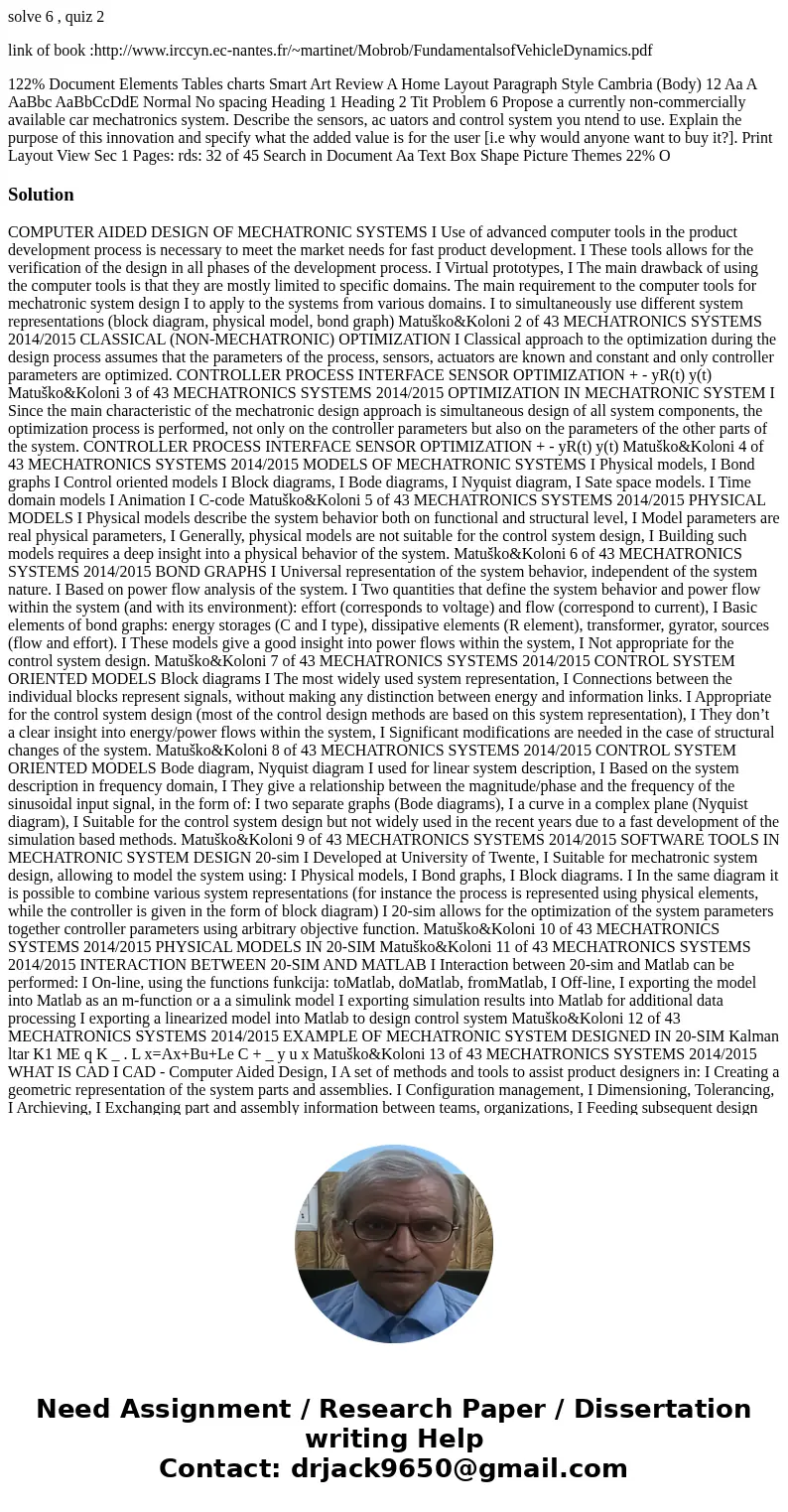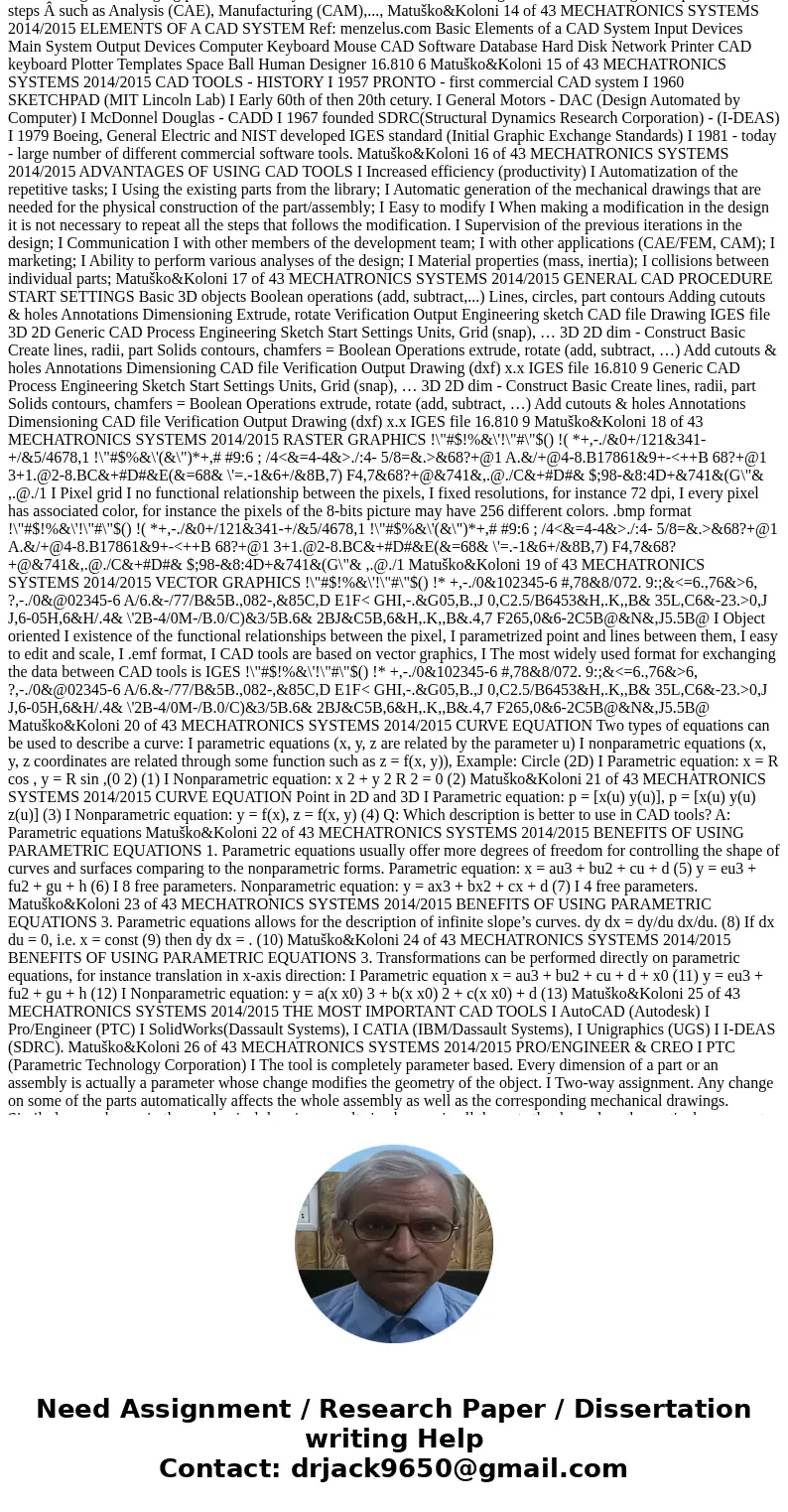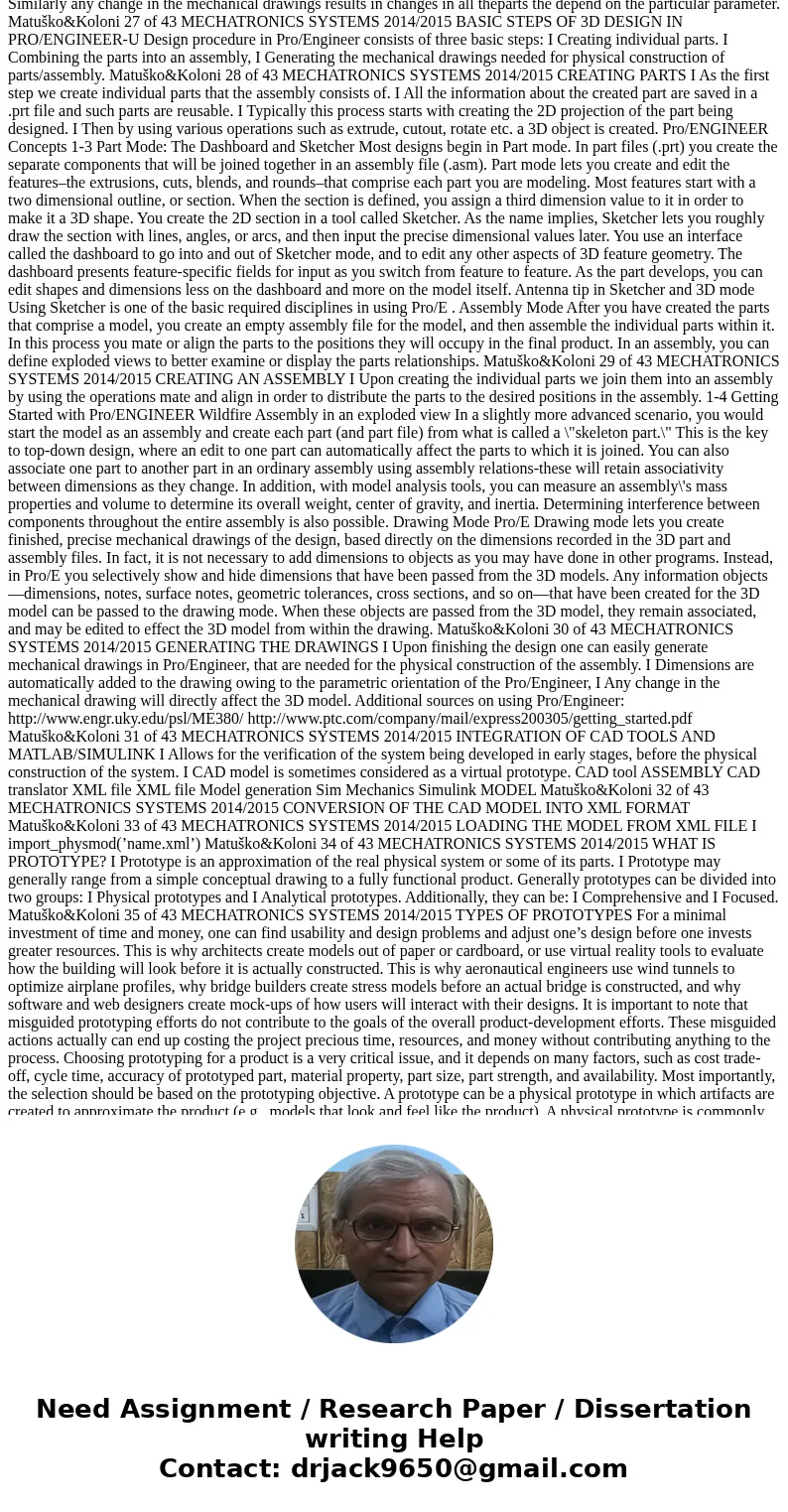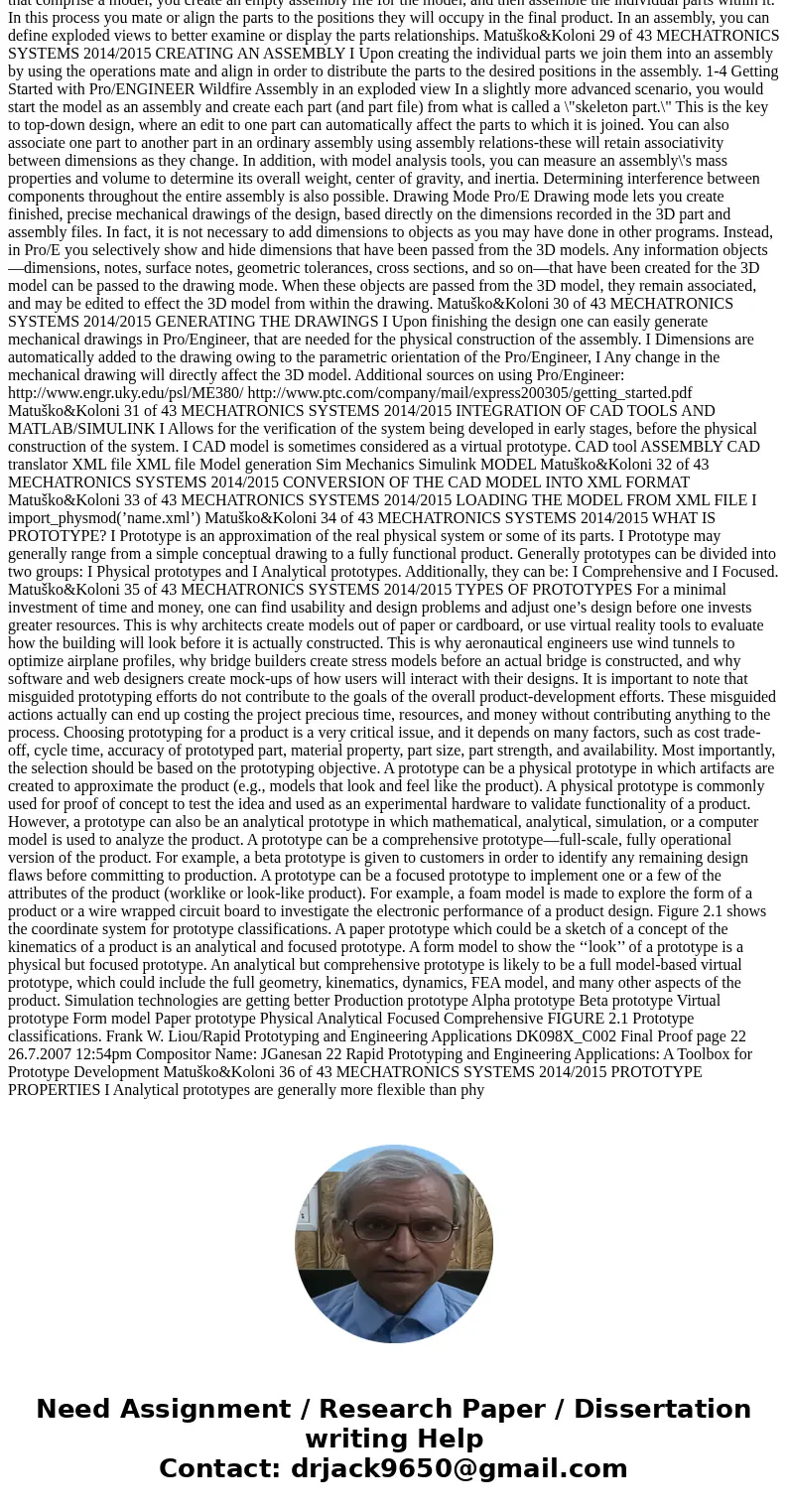solve 6 quiz 2 link of book httpwwwirccynecnantesfrmartinet
solve 6 , quiz 2
link of book :http://www.irccyn.ec-nantes.fr/~martinet/Mobrob/FundamentalsofVehicleDynamics.pdf
122% Document Elements Tables charts Smart Art Review A Home Layout Paragraph Style Cambria (Body) 12 Aa A AaBbc AaBbCcDdE Normal No spacing Heading 1 Heading 2 Tit Problem 6 Propose a currently non-commercially available car mechatronics system. Describe the sensors, ac uators and control system you ntend to use. Explain the purpose of this innovation and specify what the added value is for the user [i.e why would anyone want to buy it?]. Print Layout View Sec 1 Pages: rds: 32 of 45 Search in Document Aa Text Box Shape Picture Themes 22% OSolution
COMPUTER AIDED DESIGN OF MECHATRONIC SYSTEMS I Use of advanced computer tools in the product development process is necessary to meet the market needs for fast product development. I These tools allows for the verification of the design in all phases of the development process. I Virtual prototypes, I The main drawback of using the computer tools is that they are mostly limited to specific domains. The main requirement to the computer tools for mechatronic system design I to apply to the systems from various domains. I to simultaneously use different system representations (block diagram, physical model, bond graph) Matuško&Koloni 2 of 43 MECHATRONICS SYSTEMS 2014/2015 CLASSICAL (NON-MECHATRONIC) OPTIMIZATION I Classical approach to the optimization during the design process assumes that the parameters of the process, sensors, actuators are known and constant and only controller parameters are optimized. CONTROLLER PROCESS INTERFACE SENSOR OPTIMIZATION + - yR(t) y(t) Matuško&Koloni 3 of 43 MECHATRONICS SYSTEMS 2014/2015 OPTIMIZATION IN MECHATRONIC SYSTEM I Since the main characteristic of the mechatronic design approach is simultaneous design of all system components, the optimization process is performed, not only on the controller parameters but also on the parameters of the other parts of the system. CONTROLLER PROCESS INTERFACE SENSOR OPTIMIZATION + - yR(t) y(t) Matuško&Koloni 4 of 43 MECHATRONICS SYSTEMS 2014/2015 MODELS OF MECHATRONIC SYSTEMS I Physical models, I Bond graphs I Control oriented models I Block diagrams, I Bode diagrams, I Nyquist diagram, I Sate space models. I Time domain models I Animation I C-code Matuško&Koloni 5 of 43 MECHATRONICS SYSTEMS 2014/2015 PHYSICAL MODELS I Physical models describe the system behavior both on functional and structural level, I Model parameters are real physical parameters, I Generally, physical models are not suitable for the control system design, I Building such models requires a deep insight into a physical behavior of the system. Matuško&Koloni 6 of 43 MECHATRONICS SYSTEMS 2014/2015 BOND GRAPHS I Universal representation of the system behavior, independent of the system nature. I Based on power flow analysis of the system. I Two quantities that define the system behavior and power flow within the system (and with its environment): effort (corresponds to voltage) and flow (correspond to current), I Basic elements of bond graphs: energy storages (C and I type), dissipative elements (R element), transformer, gyrator, sources (flow and effort). I These models give a good insight into power flows within the system, I Not appropriate for the control system design. Matuško&Koloni 7 of 43 MECHATRONICS SYSTEMS 2014/2015 CONTROL SYSTEM ORIENTED MODELS Block diagrams I The most widely used system representation, I Connections between the individual blocks represent signals, without making any distinction between energy and information links. I Appropriate for the control system design (most of the control design methods are based on this system representation), I They don’t a clear insight into energy/power flows within the system, I Significant modifications are needed in the case of structural changes of the system. Matuško&Koloni 8 of 43 MECHATRONICS SYSTEMS 2014/2015 CONTROL SYSTEM ORIENTED MODELS Bode diagram, Nyquist diagram I used for linear system description, I Based on the system description in frequency domain, I They give a relationship between the magnitude/phase and the frequency of the sinusoidal input signal, in the form of: I two separate graphs (Bode diagrams), I a curve in a complex plane (Nyquist diagram), I Suitable for the control system design but not widely used in the recent years due to a fast development of the simulation based methods. Matuško&Koloni 9 of 43 MECHATRONICS SYSTEMS 2014/2015 SOFTWARE TOOLS IN MECHATRONIC SYSTEM DESIGN 20-sim I Developed at University of Twente, I Suitable for mechatronic system design, allowing to model the system using: I Physical models, I Bond graphs, I Block diagrams. I In the same diagram it is possible to combine various system representations (for instance the process is represented using physical elements, while the controller is given in the form of block diagram) I 20-sim allows for the optimization of the system parameters together controller parameters using arbitrary objective function. Matuško&Koloni 10 of 43 MECHATRONICS SYSTEMS 2014/2015 PHYSICAL MODELS IN 20-SIM Matuško&Koloni 11 of 43 MECHATRONICS SYSTEMS 2014/2015 INTERACTION BETWEEN 20-SIM AND MATLAB I Interaction between 20-sim and Matlab can be performed: I On-line, using the functions funkcija: toMatlab, doMatlab, fromMatlab, I Off-line, I exporting the model into Matlab as an m-function or a a simulink model I exporting simulation results into Matlab for additional data processing I exporting a linearized model into Matlab to design control system Matuško&Koloni 12 of 43 MECHATRONICS SYSTEMS 2014/2015 EXAMPLE OF MECHATRONIC SYSTEM DESIGNED IN 20-SIM Kalman ltar K1 ME q K _ . L x=Ax+Bu+Le C + _ y u x Matuško&Koloni 13 of 43 MECHATRONICS SYSTEMS 2014/2015 WHAT IS CAD I CAD - Computer Aided Design, I A set of methods and tools to assist product designers in: I Creating a geometric representation of the system parts and assemblies. I Configuration management, I Dimensioning, Tolerancing, I Archieving, I Exchanging part and assembly information between teams, organizations, I Feeding subsequent design steps  such as Analysis (CAE), Manufacturing (CAM),..., Matuško&Koloni 14 of 43 MECHATRONICS SYSTEMS 2014/2015 ELEMENTS OF A CAD SYSTEM Ref: menzelus.com Basic Elements of a CAD System Input Devices Main System Output Devices Computer Keyboard Mouse CAD Software Database Hard Disk Network Printer CAD keyboard Plotter Templates Space Ball Human Designer 16.810 6 Matuško&Koloni 15 of 43 MECHATRONICS SYSTEMS 2014/2015 CAD TOOLS - HISTORY I 1957 PRONTO - first commercial CAD system I 1960 SKETCHPAD (MIT Lincoln Lab) I Early 60th of then 20th cetury. I General Motors - DAC (Design Automated by Computer) I McDonnel Douglas - CADD I 1967 founded SDRC(Structural Dynamics Research Corporation) - (I-DEAS) I 1979 Boeing, General Electric and NIST developed IGES standard (Initial Graphic Exchange Standards) I 1981 - today - large number of different commercial software tools. Matuško&Koloni 16 of 43 MECHATRONICS SYSTEMS 2014/2015 ADVANTAGES OF USING CAD TOOLS I Increased efficiency (productivity) I Automatization of the repetitive tasks; I Using the existing parts from the library; I Automatic generation of the mechanical drawings that are needed for the physical construction of the part/assembly; I Easy to modify I When making a modification in the design it is not necessary to repeat all the steps that follows the modification. I Supervision of the previous iterations in the design; I Communication I with other members of the development team; I with other applications (CAE/FEM, CAM); I marketing; I Ability to perform various analyses of the design; I Material properties (mass, inertia); I collisions between individual parts; Matuško&Koloni 17 of 43 MECHATRONICS SYSTEMS 2014/2015 GENERAL CAD PROCEDURE START SETTINGS Basic 3D objects Boolean operations (add, subtract,...) Lines, circles, part contours Adding cutouts & holes Annotations Dimensioning Extrude, rotate Verification Output Engineering sketch CAD file Drawing IGES file 3D 2D Generic CAD Process Engineering Sketch Start Settings Units, Grid (snap), … 3D 2D dim - Construct Basic Create lines, radii, part Solids contours, chamfers = Boolean Operations extrude, rotate (add, subtract, …) Add cutouts & holes Annotations Dimensioning CAD file Verification Output Drawing (dxf) x.x IGES file 16.810 9 Generic CAD Process Engineering Sketch Start Settings Units, Grid (snap), … 3D 2D dim - Construct Basic Create lines, radii, part Solids contours, chamfers = Boolean Operations extrude, rotate (add, subtract, …) Add cutouts & holes Annotations Dimensioning CAD file Verification Output Drawing (dxf) x.x IGES file 16.810 9 Matuško&Koloni 18 of 43 MECHATRONICS SYSTEMS 2014/2015 RASTER GRAPHICS !\"#$!%&\'!\"#\"$() !( *+,-./&0+/121&341-+/&5/4678,1 !\"#$%&\'(&\")*+,# #9:6 ; /4<&=4-4&>./:4- 5/8=&.>&68?+@1 A.&/+@4-8.B17861&9+-<++B 68?+@1 3+1.@2-8.BC&+#D#&E(&=68& \'=.-1&6+/&8B,7) F4,7&68?+@&741&,.@./C&+#D#& $;98-&8:4D+&741&(G\"& ,.@./1 I Pixel grid I no functional relationship between the pixels, I fixed resolutions, for instance 72 dpi, I every pixel has associated color, for instance the pixels of the 8-bits picture may have 256 different colors. .bmp format !\"#$!%&\'!\"#\"$() !( *+,-./&0+/121&341-+/&5/4678,1 !\"#$%&\'(&\")*+,# #9:6 ; /4<&=4-4&>./:4- 5/8=&.>&68?+@1 A.&/+@4-8.B17861&9+-<++B 68?+@1 3+1.@2-8.BC&+#D#&E(&=68& \'=.-1&6+/&8B,7) F4,7&68?+@&741&,.@./C&+#D#& $;98-&8:4D+&741&(G\"& ,.@./1 Matuško&Koloni 19 of 43 MECHATRONICS SYSTEMS 2014/2015 VECTOR GRAPHICS !\"#$!%&\'!\"#\"$() !* +,-./0&102345-6 #,78&8/072. 9:;&<=6.,76&>6, ?,-./0&@02345-6 A/6.&-/77/B&5B.,082-,&85C,D E1F< GHI,-.&G05,B.,J 0,C2.5/B6453&H,.K,,B& 35L,C6&-23.>0,J J,6-05H,6&H/.4& \'2B-4/0M-/B.0/C)&3/5B.6& 2BJ&C5B,6&H,.K,,B&.4,7 F265,0&6-2C5B@&N&,J5.5B@ I Object oriented I existence of the functional relationships between the pixel, I parametrized point and lines between them, I easy to edit and scale, I .emf format, I CAD tools are based on vector graphics, I The most widely used format for exchanging the data between CAD tools is IGES !\"#$!%&\'!\"#\"$() !* +,-./0&102345-6 #,78&8/072. 9:;&<=6.,76&>6, ?,-./0&@02345-6 A/6.&-/77/B&5B.,082-,&85C,D E1F< GHI,-.&G05,B.,J 0,C2.5/B6453&H,.K,,B& 35L,C6&-23.>0,J J,6-05H,6&H/.4& \'2B-4/0M-/B.0/C)&3/5B.6& 2BJ&C5B,6&H,.K,,B&.4,7 F265,0&6-2C5B@&N&,J5.5B@ Matuško&Koloni 20 of 43 MECHATRONICS SYSTEMS 2014/2015 CURVE EQUATION Two types of equations can be used to describe a curve: I parametric equations (x, y, z are related by the parameter u) I nonparametric equations (x, y, z coordinates are related through some function such as z = f(x, y)), Example: Circle (2D) I Parametric equation: x = R cos , y = R sin ,(0 2) (1) I Nonparametric equation: x 2 + y 2 R 2 = 0 (2) Matuško&Koloni 21 of 43 MECHATRONICS SYSTEMS 2014/2015 CURVE EQUATION Point in 2D and 3D I Parametric equation: p = [x(u) y(u)], p = [x(u) y(u) z(u)] (3) I Nonparametric equation: y = f(x), z = f(x, y) (4) Q: Which description is better to use in CAD tools? A: Parametric equations Matuško&Koloni 22 of 43 MECHATRONICS SYSTEMS 2014/2015 BENEFITS OF USING PARAMETRIC EQUATIONS 1. Parametric equations usually offer more degrees of freedom for controlling the shape of curves and surfaces comparing to the nonparametric forms. Parametric equation: x = au3 + bu2 + cu + d (5) y = eu3 + fu2 + gu + h (6) I 8 free parameters. Nonparametric equation: y = ax3 + bx2 + cx + d (7) I 4 free parameters. Matuško&Koloni 23 of 43 MECHATRONICS SYSTEMS 2014/2015 BENEFITS OF USING PARAMETRIC EQUATIONS 3. Parametric equations allows for the description of infinite slope’s curves. dy dx = dy/du dx/du. (8) If dx du = 0, i.e. x = const (9) then dy dx = . (10) Matuško&Koloni 24 of 43 MECHATRONICS SYSTEMS 2014/2015 BENEFITS OF USING PARAMETRIC EQUATIONS 3. Transformations can be performed directly on parametric equations, for instance translation in x-axis direction: I Parametric equation x = au3 + bu2 + cu + d + x0 (11) y = eu3 + fu2 + gu + h (12) I Nonparametric equation: y = a(x x0) 3 + b(x x0) 2 + c(x x0) + d (13) Matuško&Koloni 25 of 43 MECHATRONICS SYSTEMS 2014/2015 THE MOST IMPORTANT CAD TOOLS I AutoCAD (Autodesk) I Pro/Engineer (PTC) I SolidWorks(Dassault Systems), I CATIA (IBM/Dassault Systems), I Unigraphics (UGS) I I-DEAS (SDRC). Matuško&Koloni 26 of 43 MECHATRONICS SYSTEMS 2014/2015 PRO/ENGINEER & CREO I PTC (Parametric Technology Corporation) I The tool is completely parameter based. Every dimension of a part or an assembly is actually a parameter whose change modifies the geometry of the object. I Two-way assignment. Any change on some of the parts automatically affects the whole assembly as well as the corresponding mechanical drawings. Similarly any change in the mechanical drawings results in changes in all theparts the depend on the particular parameter. Matuško&Koloni 27 of 43 MECHATRONICS SYSTEMS 2014/2015 BASIC STEPS OF 3D DESIGN IN PRO/ENGINEER-U Design procedure in Pro/Engineer consists of three basic steps: I Creating individual parts. I Combining the parts into an assembly, I Generating the mechanical drawings needed for physical construction of parts/assembly. Matuško&Koloni 28 of 43 MECHATRONICS SYSTEMS 2014/2015 CREATING PARTS I As the first step we create individual parts that the assembly consists of. I All the information about the created part are saved in a .prt file and such parts are reusable. I Typically this process starts with creating the 2D projection of the part being designed. I Then by using various operations such as extrude, cutout, rotate etc. a 3D object is created. Pro/ENGINEER Concepts 1-3 Part Mode: The Dashboard and Sketcher Most designs begin in Part mode. In part files (.prt) you create the separate components that will be joined together in an assembly file (.asm). Part mode lets you create and edit the features–the extrusions, cuts, blends, and rounds–that comprise each part you are modeling. Most features start with a two dimensional outline, or section. When the section is defined, you assign a third dimension value to it in order to make it a 3D shape. You create the 2D section in a tool called Sketcher. As the name implies, Sketcher lets you roughly draw the section with lines, angles, or arcs, and then input the precise dimensional values later. You use an interface called the dashboard to go into and out of Sketcher mode, and to edit any other aspects of 3D feature geometry. The dashboard presents feature-specific fields for input as you switch from feature to feature. As the part develops, you can edit shapes and dimensions less on the dashboard and more on the model itself. Antenna tip in Sketcher and 3D mode Using Sketcher is one of the basic required disciplines in using Pro/E . Assembly Mode After you have created the parts that comprise a model, you create an empty assembly file for the model, and then assemble the individual parts within it. In this process you mate or align the parts to the positions they will occupy in the final product. In an assembly, you can define exploded views to better examine or display the parts relationships. Matuško&Koloni 29 of 43 MECHATRONICS SYSTEMS 2014/2015 CREATING AN ASSEMBLY I Upon creating the individual parts we join them into an assembly by using the operations mate and align in order to distribute the parts to the desired positions in the assembly. 1-4 Getting Started with Pro/ENGINEER Wildfire Assembly in an exploded view In a slightly more advanced scenario, you would start the model as an assembly and create each part (and part file) from what is called a \"skeleton part.\" This is the key to top-down design, where an edit to one part can automatically affect the parts to which it is joined. You can also associate one part to another part in an ordinary assembly using assembly relations-these will retain associativity between dimensions as they change. In addition, with model analysis tools, you can measure an assembly\'s mass properties and volume to determine its overall weight, center of gravity, and inertia. Determining interference between components throughout the entire assembly is also possible. Drawing Mode Pro/E Drawing mode lets you create finished, precise mechanical drawings of the design, based directly on the dimensions recorded in the 3D part and assembly files. In fact, it is not necessary to add dimensions to objects as you may have done in other programs. Instead, in Pro/E you selectively show and hide dimensions that have been passed from the 3D models. Any information objects—dimensions, notes, surface notes, geometric tolerances, cross sections, and so on—that have been created for the 3D model can be passed to the drawing mode. When these objects are passed from the 3D model, they remain associated, and may be edited to effect the 3D model from within the drawing. Matuško&Koloni 30 of 43 MECHATRONICS SYSTEMS 2014/2015 GENERATING THE DRAWINGS I Upon finishing the design one can easily generate mechanical drawings in Pro/Engineer, that are needed for the physical construction of the assembly. I Dimensions are automatically added to the drawing owing to the parametric orientation of the Pro/Engineer, I Any change in the mechanical drawing will directly affect the 3D model. Additional sources on using Pro/Engineer: http://www.engr.uky.edu/psl/ME380/ http://www.ptc.com/company/mail/express200305/getting_started.pdf Matuško&Koloni 31 of 43 MECHATRONICS SYSTEMS 2014/2015 INTEGRATION OF CAD TOOLS AND MATLAB/SIMULINK I Allows for the verification of the system being developed in early stages, before the physical construction of the system. I CAD model is sometimes considered as a virtual prototype. CAD tool ASSEMBLY CAD translator XML file XML file Model generation Sim Mechanics Simulink MODEL Matuško&Koloni 32 of 43 MECHATRONICS SYSTEMS 2014/2015 CONVERSION OF THE CAD MODEL INTO XML FORMAT Matuško&Koloni 33 of 43 MECHATRONICS SYSTEMS 2014/2015 LOADING THE MODEL FROM XML FILE I import_physmod(’name.xml’) Matuško&Koloni 34 of 43 MECHATRONICS SYSTEMS 2014/2015 WHAT IS PROTOTYPE? I Prototype is an approximation of the real physical system or some of its parts. I Prototype may generally range from a simple conceptual drawing to a fully functional product. Generally prototypes can be divided into two groups: I Physical prototypes and I Analytical prototypes. Additionally, they can be: I Comprehensive and I Focused. Matuško&Koloni 35 of 43 MECHATRONICS SYSTEMS 2014/2015 TYPES OF PROTOTYPES For a minimal investment of time and money, one can find usability and design problems and adjust one’s design before one invests greater resources. This is why architects create models out of paper or cardboard, or use virtual reality tools to evaluate how the building will look before it is actually constructed. This is why aeronautical engineers use wind tunnels to optimize airplane profiles, why bridge builders create stress models before an actual bridge is constructed, and why software and web designers create mock-ups of how users will interact with their designs. It is important to note that misguided prototyping efforts do not contribute to the goals of the overall product-development efforts. These misguided actions actually can end up costing the project precious time, resources, and money without contributing anything to the process. Choosing prototyping for a product is a very critical issue, and it depends on many factors, such as cost trade-off, cycle time, accuracy of prototyped part, material property, part size, part strength, and availability. Most importantly, the selection should be based on the prototyping objective. A prototype can be a physical prototype in which artifacts are created to approximate the product (e.g., models that look and feel like the product). A physical prototype is commonly used for proof of concept to test the idea and used as an experimental hardware to validate functionality of a product. However, a prototype can also be an analytical prototype in which mathematical, analytical, simulation, or a computer model is used to analyze the product. A prototype can be a comprehensive prototype—full-scale, fully operational version of the product. For example, a beta prototype is given to customers in order to identify any remaining design flaws before committing to production. A prototype can be a focused prototype to implement one or a few of the attributes of the product (worklike or look-like product). For example, a foam model is made to explore the form of a product or a wire wrapped circuit board to investigate the electronic performance of a product design. Figure 2.1 shows the coordinate system for prototype classifications. A paper prototype which could be a sketch of a concept of the kinematics of a product is an analytical and focused prototype. A form model to show the ‘‘look’’ of a prototype is a physical but focused prototype. An analytical but comprehensive prototype is likely to be a full model-based virtual prototype, which could include the full geometry, kinematics, dynamics, FEA model, and many other aspects of the product. Simulation technologies are getting better Production prototype Alpha prototype Beta prototype Virtual prototype Form model Paper prototype Physical Analytical Focused Comprehensive FIGURE 2.1 Prototype classifications. Frank W. Liou/Rapid Prototyping and Engineering Applications DK098X_C002 Final Proof page 22 26.7.2007 12:54pm Compositor Name: JGanesan 22 Rapid Prototyping and Engineering Applications: A Toolbox for Prototype Development Matuško&Koloni 36 of 43 MECHATRONICS SYSTEMS 2014/2015 PROTOTYPE PROPERTIES I Analytical prototypes are generally more flexible than phy




 Homework Sourse
Homework Sourse